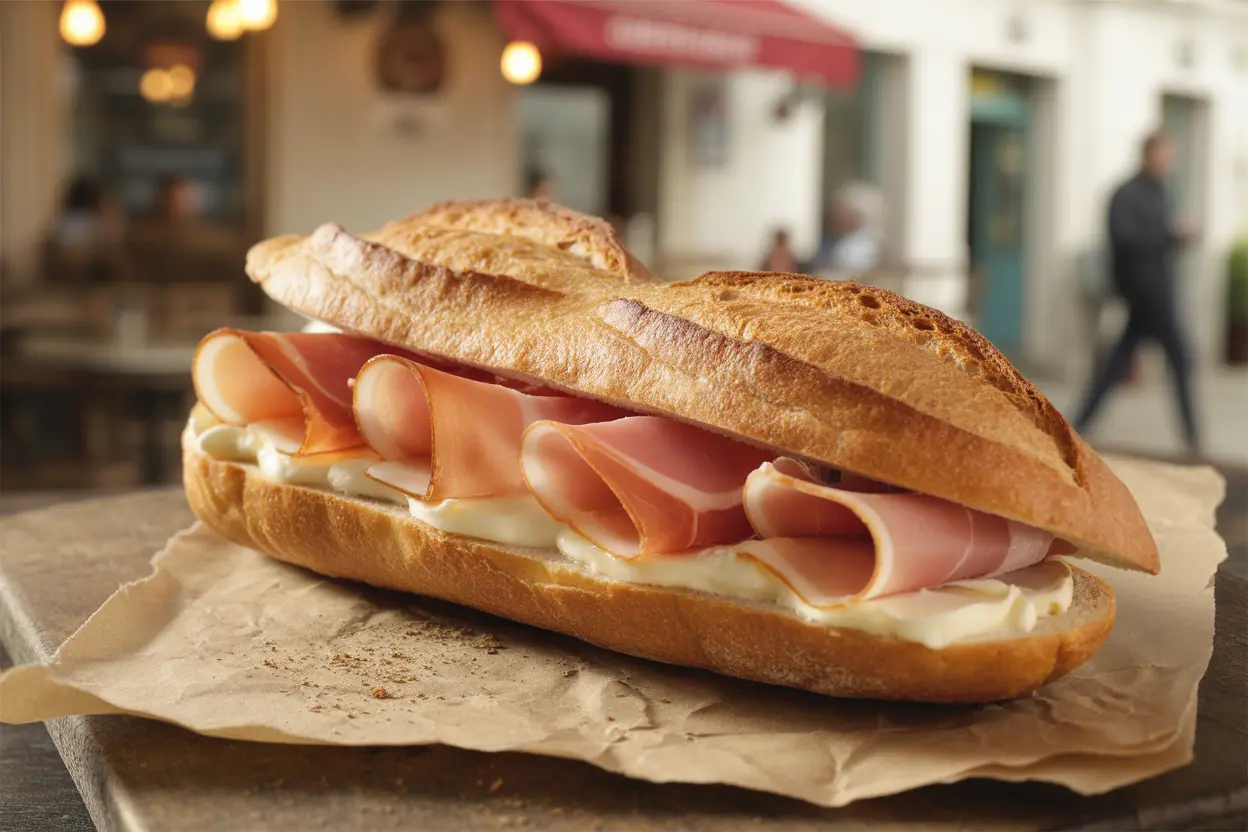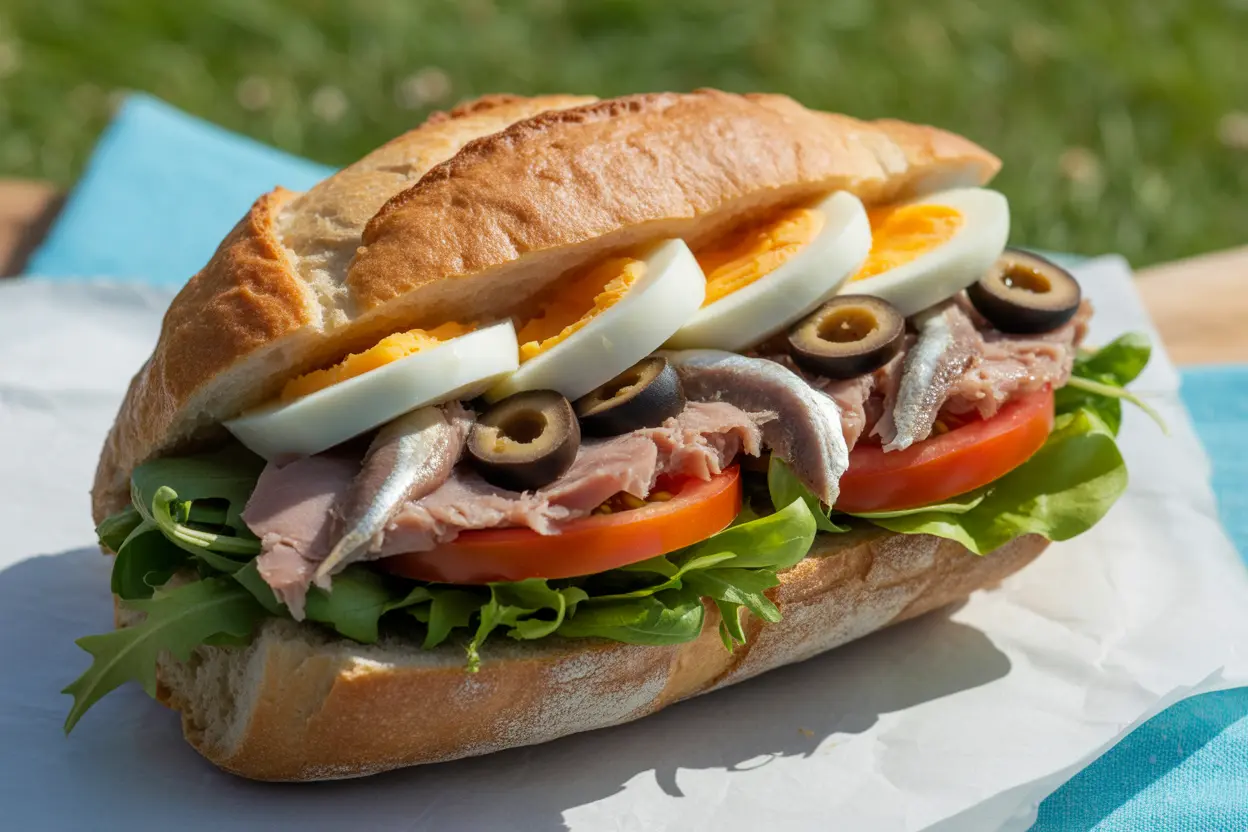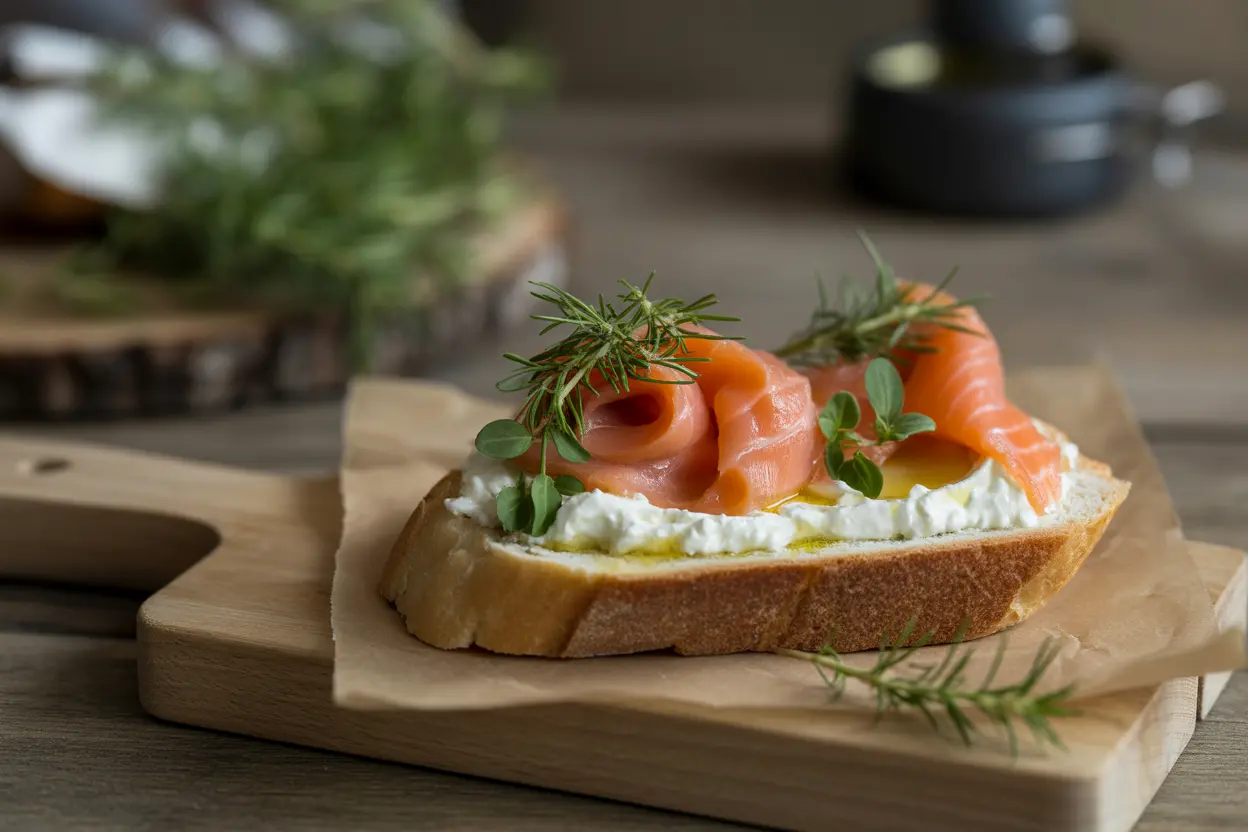Definition and Overview
When you think of traditional French sandwiches, what pops into your mind? Is it the crunchy French baguette stuffed with savory fillings or perhaps the elegant simplicity that defines French cuisine? At their core, traditional French sandwiches are humble yet iconic creations made with quality ingredients and a touch of culinary savoir-faire. These sandwiches are not just meals; they are expressions of French culinary tradition that blend flavors, textures, and history into every bite.
Exploring traditional French sandwiches invites you into a world where simple ingredients like fresh bread, creamy butter, and delicate ham come together in harmony. If you’re curious about crafting these delights at home, resources such as the classic Jambon-Beurre recipe offer a glimpse into the essential components of the traditional French ham sandwich ingredients that make these sandwiches so beloved.

Historical and Cultural Significance
The roots of traditional French sandwiches stretch deep into the fabric of France’s food culture, intertwined with its art of baking, charcuterie, and cheese-making. The French bread heritage is celebrated in the history of the French baguette, which serves as a pillar for many of these sandwiches. These sandwiches have historically been the go-to meals for workers, students, and families, cherished for their convenience and taste.
More than just a quick bite, traditional French sandwiches have become a cultural icon—featured in Parisian cafés and countryside picnics alike. Their simplicity reflects the French food culture, where each ingredient tells a story and honors regional flavors. Whether enjoyed during a bustling lunch break or an afternoon escape, these sandwiches capture the essence of French gastronomy.
The Classic Jambon-Beurre Sandwich
Ingredients and Preparation
Among the pantheon of traditional French sandwiches, the Jambon-Beurre reigns supreme—a timeless classic cherished across France. At its simplest, this sandwich features a freshly baked French baguette sliced open and generously spread with creamy French butter, then layered with thinly sliced, delicate Jambon de Paris (Parisian ham). Occasionally, a whisper of Dijon mustard adds a slight piquancy, but the magic lies in the balance between the crusty bread, rich butter, and tender ham.
Preparation is as minimalist as the ingredients themselves. Start with a warm baguette, ideally from a local boulangerie, and slice it lengthwise. Spread butter edge to edge, ensuring that every bite delights the senses. Add the Jambon de Paris slices, and voilà, you have a sandwich that embodies classic French sandwich ideas. If you want to explore tips on bread choices and fillings, check out some varieties of fillings for baguette sandwiches.
Why Jambon-Beurre Is Iconic in French Cuisine
What makes the Jambon-Beurre so iconic? It’s the celebration of simplicity done right. This sandwich exemplifies the French knack for letting premium ingredients shine without overcomplicating the recipe. It’s not about piling on countless toppings but rather the quality and freshness of each component.
Its widespread popularity is also about accessibility—found everywhere from bustling street markets to chic Parisian cafés. Eating a Jambon-Beurre is like tasting a piece of French culture; it’s the perfect harmony of texture—the crunch of the baguette, the softness of the butter, and the savory chew of ham. Plus, it beautifully mirrors the French culinary tradition of respecting and elevating basic ingredients.
Where to Find the Best Jambon-Beurre
Dreaming of the ultimate Jambon-Beurre experience? Paris is undoubtedly the mecca for where to enjoy authentic French sandwiches. Numerous boulangeries and sandwich shops compete for the title, but spots like those listed in the best places for French sandwiches in Paris guide are sure bets.
Locals swear by the freshness of the baguette and the finesse in ham slicing. Whether grabbing a quick lunch or sitting down to savor every bite, the best Jambon-Beurre sandwiches boast impeccable balance and authenticity that transports you straight to the heart of French cuisine.
Other Popular Traditional French Sandwiches
Croque Monsieur and Croque Madame
Ah, the Croque Monsieur—delectably toasted, dripping with béchamel, ham, and melted cheese. This sandwich elevates the humble ham and cheese into a warm, gooey masterpiece. If you’ve ever wondered about the difference between a Croque Monsieur and a simple sandwich, think of it as the French version of comfort food, with the sandwich griddled or baked until golden and bubbly.
The Croque Madame adds a sunny-side-up egg on top, transforming the sandwich into a morning or brunch favorite. These sandwiches reflect the French fast food scene but with a gourmet twist. Curious how to nail this at home? The Croque Monsieur recipe breaks down the layering of flavors perfectly.

Pan Bagnat: A Niçoise Specialty
Travel to the south of France, and you’ll meet the Pan Bagnat, a robust Niçoise salad sandwich packed with tuna, olives, anchovies, hard-boiled eggs, and fresh veggies all swaddled within the crusty bread. This sandwich sings of Mediterranean flavors and is a true regional treasure.
Enjoying a Pan Bagnat is like taking a mini vacation to Nice—fresh, vibrant, and deeply satisfying. It’s perfect for warm weather lunches and a staple in French picnic sandwiches.

Pâté-Cornichon: Rustic French Flavors
If you crave a slice of rustic France, the Pâté-Cornichon is your best bet. This sandwich layers rich, flavorful French charcuterie pâté with crunchy cornichons (small pickles) inside a baguette. It’s a combo of smooth, tangy, and crunchy that celebrates French butter and regional charcuterie craftsmanship.
This sandwich is a must-try for anyone wanting to experience the earthy, authentic side of French sandwich culture.
Tartine: The Open-Faced Delight
Last but not least, the Tartine flips the sandwich idea on its head: open-faced, artfully topped bread slices that look as good as they taste. From simple butter and jam to smoked salmon or creamy goat cheese with herbs, the Tartine is a versatile and elegant part of the French sandwich variations.
Its beauty lies not only in flavor but presentation—a perfect bite that brings a fresh perspective to the sandwich tradition.

Key Ingredients in Traditional French Sandwiches
The Importance of the French Baguette
If there’s one crucial type of sandwich breads that defines traditional French sandwiches, it’s the baguette. This long, slender bread with its crackling crust and soft, airy interior is the backbone of countless recipes. The baguette’s texture provides that satisfying crunch that contrasts beautifully with creamy or savory fillings.
Crafting a perfect baguette involves a delicate balance of flour, water, yeast, and salt, which results in a bread that’s both rustic and refined. If you want to dive deeper into baguette varieties, check out the post on French Bread Sandwich Recipes: Classic & Creative Ideas.
Ham Varieties: Jambon de Paris and More
Not all ham is created equal. The famed Jambon de Paris is the go-to choice for many traditional sandwiches due to its tender, mild flavor and smooth texture. Unlike heavily smoked or cured hams, Jambon de Paris offers a subtle saltiness that harmonizes well with butter and bread.
This ham variety embodies the ethos of French sandwich fillings—minimalist yet flavor-packed.
Butter, Cheese, and Other Essential Fillings
No French sandwich is complete without quality French butter, known for its creamy, slightly nutty taste. Cheese varieties such as Emmental and Comté frequently join the fray, especially in sandwiches like the Croque Monsieur.
Other staples include cornichons, mustard, and fresh vegetables, all contributing layers of flavor and texture that elevate the sandwich beyond simple bread and meat.
How to Make a Traditional French Sandwich at Home
Choosing Authentic Ingredients
Creating an authentic traditional French sandwich at home starts with sourcing the right ingredients. Opt for a freshly baked baguette from a trusted bakery or try baking one yourself. Select Jambon de Paris or quality French ham, ideally unsmoked and tender.
Don’t skimp on French butter—its rich texture is crucial. Complement with slices of Emmental or Gruyère cheese and pick up some Dijon mustard for that classic zing. Visiting local specialty stores or ordering online can help you gather these essentials.
Step-by-Step Preparation Guide
- Begin by slicing the baguette horizontally, but not all the way through—leave it as a hinged loaf.
- Generously spread room-temperature French butter on both inner sides, covering every nook.
- Layer thin slices of Jambon de Paris evenly across the buttered bread.
- Optionally, add a light smear of Dijon mustard for a peppery kick.
- Close the sandwich gently, pressing slightly to meld the ingredients.
For more detailed stepwise sandwich making tips, the How to Make Baguette Sandwich: Step-by-Step Guide is an excellent resource.
Tips for Serving and Storing
Serve your sandwich fresh to enjoy the contrast between the crunchy bread and soft fillings. If storing, wrap it tightly in parchment or wax paper and consume within the day to preserve freshness.
Avoid refrigeration when possible, as it can harden the bread. When traveling or picnicking, keep the sandwich cool in an insulated bag.
The Role of French Sandwiches in Modern French Culture
Sandwiches in French Cafés and Bistros
Traditional French sandwiches remain a staple in popular bread choices in cafés, where they complement coffee breaks and leisurely lunches. They embody the relaxed, convivial atmosphere of French café life, balancing speed with culinary quality.
Cafés pride themselves on fresh breads and classic fillings, making these sandwiches a quick yet satisfying meal amid busy days.
French Sandwiches and Travel
For travelers, tasting traditional French sandwiches is a passport to authentic local flavors. Whether enjoying a French picnic sandwich overlooking the Seine or grabbing a quick bite at a market stall, these sandwiches offer a delicious glimpse into regional specialties and historical foodways.
Embracing these sandwiches during your travels bridges culture, history, and taste in an unforgettable way.
FAQs
What is the traditional French sandwich called?
The most iconic traditional French sandwich is the Jambon-Beurre, made with a crisp baguette, fresh butter, and thin slices of Jambon de Paris. This sandwich epitomizes the French love for quality, simplicity, and freshness, standing as a culinary classic found throughout France, especially in Parisian boulangeries.
What ingredients are in a classic Jambon-Beurre?
A classic Jambon-Beurre includes a freshly baked French baguette, French butter spread generously, and delicate slices of Jambon de Paris. Optional touches like Dijon mustard add subtle flavor but the sandwich’s magic lies in its minimalist, high-quality ingredients.
How is a Croque Monsieur different from a regular sandwich?
The Croque Monsieur is a French toasted ham and cheese sandwich that is baked or fried with béchamel sauce and topped with melted cheese. Unlike regular sandwiches that are served cold, the Croque Monsieur is warm, crispy, and indulgently cheesy. When topped with a fried egg, it becomes a Croque Madame.
Can I make a traditional French sandwich at home?
Absolutely! By choosing authentic ingredients like a crisp baguette, Jambon de Paris, and quality butter, and following simple preparation steps, you can craft traditional French sandwiches at home. Guides like the stepwise sandwich making tips can help perfect your technique.
Where can I try authentic French sandwiches?
Authentic French sandwiches are best experienced in France, especially Paris. The city’s boulangeries and cafés offer some of the finest examples, and the best places for French sandwiches in Paris list can guide you to top spots. Outside France, look for French bakeries dedicated to traditional methods.
Conclusion
Traditional French sandwiches like the Jambon-Beurre symbolize simplicity, quality ingredients, and a rich culinary culture. From the iconic baguette and ham to regional specialties such as Pan Bagnat and Croque Monsieur, these sandwiches remain beloved staples both in France and worldwide. Embracing authentic ingredients and preparation methods at home allows anyone to enjoy a genuine taste of France, while understanding their cultural context adds appreciation for this culinary tradition.
